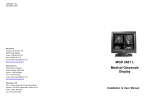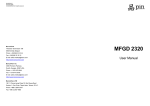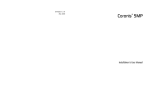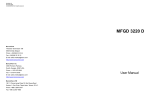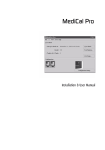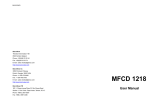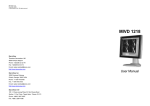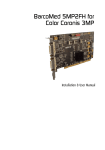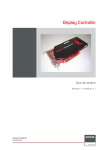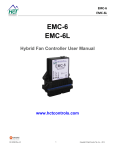Download Full user manual mfgd 2320 new signal board.p65
Transcript
B4100339 / 01 September 2003 © 2003 BARCO NV. All rights reserved BarcoView Theodoor Sevenslaan 106 8500 Kortrijk, Belgium Phone: +32(0)56 23 32 44 Fax: +32(0)56 23 33 74 E-mail: [email protected] http://www.barcoview.com BarcoView Inc 3059 Premiere Parkway Duluth, Georgia, 30097,USA Phone: +1 678 475 8000 Fax: +1 678 475 8100 E-mail: [email protected] http://www.barcoview.com BarcoView LTD 16F-1, Cheng Loong Plaza 33, Min Sheng Road Section 1, Pan Chiao, Taipei Hsien, Taiwan, R.O.C. Phone: +886 2 2957 8357 Fax: +886 2 2957 4080 MFGD 2320 User Manual CONTENTS 1.Overview ............................................................................................................ 6 1.1. Introduction .............................................................................................. 6 1.2. Package contents .................................................................................... 7 1.3. Controls and connectors ......................................................................... 8 Front ........................................................................................................... 8 Side ............................................................................................................ 8 Rear ........................................................................................................... 9 2. Installation ..................................................................................................... 10 2.1. Precautions ........................................................................................... 10 2.2. Before installing the display .................................................................. 10 2.3. Portrait or landscape position ................................................................ 11 2.4. Connecting the signals .......................................................................... 11 2.5. Routing the signal cables ...................................................................... 13 2.6. Using the USB hub ................................................................................ 14 2.7. Tilt and swivel positioning ...................................................................... 14 2.8. Starting up ............................................................................................. 14 3. Operation ...................................................................................................... 15 3.1. Switching to stand-by position ............................................................... 15 3.2. Controlling the display ........................................................................... 15 About the on-screen menus .................................................................... 15 Navigating through the menus ................................................................. 15 Saving changes ....................................................................................... 16 3.3. Using the Autoset* functions ................................................................. 17 When do you need to use the Autoset functions? ................................... 17 Required test pattern ............................................................................... 17 To enter the Autoset menu: ...................................................................... 17 The Autoset menu contains the following items: ..................................... 18 3.4. Controlling Video Contrast* and Video Brightness* .............................. 18 To enter the menu: ................................................................................... 18 To change Video Contrast or Video Brightness manually: ...................... 19 To select the calibrated position: ............................................................. 19 Additional information .............................................................................. 19 3.5. Setting the Luminance value ................................................................. 19 3.6. Making adjustments .............................................................................. 20 How to make the adjustments? ............................................................... 20 Geometry adjustments ............................................................................. 21 Phase adjustments* ................................................................................. 22 3.7. Selecting inputs ..................................................................................... 22 To enter the Inputs menu: ........................................................................ 22 You can select the following input selection settings: .............................. 23 3.8. Settings ................................................................................................. 23 To enter the Settings menu: ..................................................................... 23 The Settings menu contains the following items: .................................... 24 3.9. Preset .................................................................................................... 24 To enter the Preset menu: ....................................................................... 24 The Preset menu contains the following items: ....................................... 25 3.10 Getting information ............................................................................... 25 To enter the Information menu: ................................................................ 25 The General Information menu contains the following items: ................. 26 The Current Input Format information menu contains the following items:26 4. Advanced functions ....................................................................................... 27 4.1. About this chapter ................................................................................. 27 About the Advanced functions ................................................................. 27 To log in as advanced user: ..................................................................... 27 4.2. Advanced functions in the Adjustments menu ..................................... 28 Geometry ................................................................................................. 28 Ambient Light Compensation .................................................................. 28 Low Pass Filter* ....................................................................................... 29 4.3. Advanced functions in the Settings menu ............................................. 29 Display function ....................................................................................... 29 Input Mode ............................................................................................... 29 OSD position ............................................................................................ 31 4.4. Advanced functions in the Preset menu ................................................ 31 Clear user presets ................................................................................... 31 4.5 Advanced functions in the Information menu ......................................... 31 Service ..................................................................................................... 31 Firmware .................................................................................................. 32 Runtimes .................................................................................................. 32 5. Maintenance ................................................................................................. 33 Panel ........................................................................................................ 33 Cabinet ..................................................................................................... 33 Removing dust from the rear of the glass panel ...................................... 33 6. Troubleshooting ............................................................................................ 34 Windows does not show the desired display settings .................................. 34 Pixel Faults ................................................................................................... 34 7. Technical specifications ................................................................................ 35 SAFETY INSTRUCTIONS Read the safety and operating instructions before operating the apparatus. Retain safety and operating instructions for future reference. Adhere to all warnings on the apparatus and in the operating instructions manual. Follow all instructions for operation and use. This app aratus conforms to apparatus to: CE, IEC 60950, UL 60950, CAN/CSA C22.2 No. 950-95 (cUL) Usage in Hazardous locations Class I equipment Equipment not suitable for use in the presence of a flammable anesthetic mixture with air or with oxygen or nitrous oxide. FCC notice This equipment has been tested and found to comply with the limits of a class A digital device, pursuant to Part 15 of the FCC rules. These limits are designed to provide reasonable protection against harmful interference when the equipment is operated in a commercial environment. This equipment generates, uses and can radiate radio frequency energy and, if not installed and used in accordance with the instruction manual, may cause harmful interference to radio communications. Operation of this equipment in a residential area is likely to cause harmful interference in which case the user will be required to correct the interference at his own expense. Power connection • Power requirements: The apparatus must be powered using the 12 VDC power supply that is supplied with the apparatus. The 12 VDC power supply must be powered by the AC mains voltage. User manual MFGD 2320 • Power cord with CEE 7 plug ( ): The colors of the mains lead are colored in accordance with the following code: Green-and-yellow: Earth (safety earth), Blue: Neutral, Brown: Line • Power cord with ANSI 73.11 plug ( ): The wires of the power cord are colored in accordance with the following code: Green/ yellow: ground, White: neutral, Black: line (live) • Power requirements: connect the apparatus to an AC voltage as indicated at its back. Using a lower voltage, the apparatus will not be able to operate. Using a higher voltage may damage the apparatus. If you are not sure of the type of power supplied, consult the power company. • Do not overload wall outlets and extension cords as this may result in fire or electric shock. • Mains lead protection (U.S.: Power cord): Supply cords should be routed so that they are not likely to be walked upon or pinched by items placed upon or against them, paying particular attention to cords at plugs and receptacles. Water and moisture Never expose the apparatus to rain or moisture. Never use the apparatus near water - e.g. near a bathtub, washbasin, swimming pool, kitchen sink, laundry tub or in a wet basement. Ventilation Do not cover or block the ventilation openings in the cover of the set. When installing the apparatus in a cupboard or another closed location, heed the necessary space between the set and the sides of the cupboard. Inst allation Installation Place the apparatus on a flat, solid and stable surface that can bear the weight of at least 3 monitors. If you use an unstable cart or stand, the set may fall, causing serious injury to a child or adult, and serious damage to the equipment. More warnings in the Installation chapter. 3 1. OVER VIEW OVERVIEW 1.1. Introduction The MFGD 2320, BARCO’s 20” 2 megapixel grayscale LCD display, guarantees perfect image quality in medical imaging applications. The display combines a TFT (thin film transistor) liquid crystal display panel structure and a built-in backlight with inverter for a better picture quality. It is designed to meet the users’ needs for performance, consistency, and outstanding image quality through a streamlined development process. If the Portrait Accelerator option is installed, the display can be used in portrait or landscape version, simply by turning the panel. The tilt & swivel foot allows ideal positioning of the panel, in height and viewing angle. The panel can be adjusted by means of a control wheel on the display. I-Guard I-GUARD® is Barco’s patent-pending, built-in calibration device, continuously maintaining image quality. With I-GUARD®, QA checks no longer need to disturb normal radiology activities, as they can be performed while applications are running. I-GUARD® allows radiologists or QA administrators to calibrate their viewing stations or adjust the panel’s curve to DICOM standards without administrator intervention. Autoset feature The display has an Autoset feature that helps the user to adjust standard presets: With one single function, you can automatically adjust the display completely. Autoscan When you connect a video signal, the display checks in the internal memory if the signal has been adjusted before. If so, it selects the settings and parameters that match the connected signal. When you connect a video signal that hasn’t been connected before, and adjust the display to the signal, the adjustments and signal timing parameters are stored in a programmable preset. User manual MFGD 2320 4 Best resolution The optimum and recommended resolution is 1600 x 1200 or 1200 x 1600 (if the Portrait Accelerator option is installed). The recommended refresh rate is 60 Hz. Would you have trouble selecting a proper display setting in Windows, please refer to the Troubleshooting section further further.. BARCO’s BarcoMed 2MP2FH imaging board is the best choice to drive the MFGD 2320 display. Power saving (DPMS) The MFGD 2320 is equipped with a power saving system. When left idle for a certain time, the computer connected to the display, will power down the display. The power saving system can be switched on or off using the on-screen menus. This system requires a computer imaging board that supports power saving management. Ambient Light Compensation (ALC) When enabled, the ALC system automatically adapts the display light output, depending on the ambient light in the room. The ambient light is measured by the ALC optical sensor located at the front of the display. 1.2. Package content s contents The package should include the following items, please check. If some of the items are missing, please contact the reseller from whom you have purchased the unit. - The MFGD 2320 display - Power supply - DVI cable - Analog video cable - USB cable - Two velcro strips to bind the cables - European power cord - American power cord - This user manual If the display is part of a Coronis system, the package contains more items. Please refer to the packing list on the outside of the Coronis box. User manual MFGD 2320 5 1.3. Controls and connectors Front (1) Ambient Light Compensation (ALC) sensor (2) Power LED - The LED is off when the display is off. - The LED is green when the display is on (when enabled in the onscreen menus). - The LED is orange when the display is in Stand-by power-saving mode. 1 2 Side (3) USB downstream connector (4) Control wheel for navigating through the on-screen display (OSD) menus and changing values in the menus 4 3 User manual MFGD 2320 6 Rear (5) Digital DVI (video and data) input (6) D15 (VGA) video connector (7) Vertical sync input (8) Composite / Horizontal sync input (9) Composite video input (10) USB downstream connector (11) USB upstream connector (12) DC 12V power input DVI 5 User manual MFGD 2320 D15 VS CS/HS VIDEO 6 7 8 9 10 11 12 7 2. INST ALLA TION INSTALLA ALLATION 2.1. Precautions • Keep your original packaging. It is designed for this display and is the ideal protection during transport. • Avoid reflections in the flat panel to reduce eye strain. • Place the display on a strong and stable table or desk. • Keep the display away from heat sources and provide enough ventilation in case it is built in a rack or console. • Make sure all equipment is switched off before connecting the signals. 2.2. Before inst alling the display installing Import ant: Important: In the factory, the height-positioning system in the display foot is blocked with a strap to prevent damage during transportation. Before installing the display, you must remove this strap. Strap To remove the strap: 1 Position the display with its rear side facing you. 2 Lift up the 2 clips of the foot cover to release the cover from the foot. 3 Pull the lower side of the cover towards you and simultaneously slide the cover downward. 4 Pull the red strap out of the fixation holes in the foot. You can better leave the cover off the foot while connecting the signal cables to the display. User manual MFGD 2320 8 2.3. Portrait or landscape position You can change the orientation of the panel at any time, but it is more convenient to select landscape or portrait orientation before connecting the cables. To change the panel orientation: 1 Stand at the front side of the panel and take the panel at both sides. anel before changing the orient ation. 2 Very important: Tilt the p panel orientation. Should you change the panel orientation without tilting it first, you might irreversibly damage the tilt & swivel mechanism. 3 To change from portrait to landscape, turn the panel counterclockwise while tilting it slightly. To change from landscape to portrait, turn clockwise. 2.4. Connecting the signals To get access to the connectors, open the cover of the connector compartment by pulling down the 2 clips of the cover. The signal cables can be routed inside the display foot. Therefore, remove the foot cover before connecting the signals (see "Before installing the display"). Import ant: Important: Do not connect video and sync signals to the BNC and D15 connectors at the same time. To connect DVI signals: 1 Connect one end of the DVI cable to the DVI input (5) of the display. 2 Connect the other end of the DVI cable to the video output of your DVI signal source. 3 Route the cable so that it enters the connector compartment at the place where the cover is bulged. User manual MFGD 2320 9 To connect analog video & sync signals on BNC: Connect the video & sync output of the signal source to the video and sync inputs (9), (8) and (7) of the display. The inputs accept the following signals: • Video with separate horizontal and vertical sync. - The connection consists of 3 cables. Connect the video signal to the connector Video (9). Connect the horizontal sync signal to the connector HS/CS (8). Connect the vertical sync signal to the connector VS (7). Make sure the signal connected to the HS/CS connector does not cont ain Composite sync. contain • Video with external composite sync. The connection consists of 2 cables. Connect the video signal to the connector Video (9). Connect the composite sync signal to the connector HS/CS (8). Make sure no signal is connected to the VS connector connector.. • Video with internal composite sync (sync on video). The connection consists of 1 cable. Connect the video (with sync) signal to the connector Video (9). Notes Notes: • The video inputs cannot be connected in loop-through (daisy-chain). • The required video amplitude: 700 mV ± 3 dB. • The required sync. amplitude: - VS input: 700 mV to 4 V - HS/CS input: 500 mV to 4V - Video input (sync on video): 150 mV to 600 mV To connect analog video & sync signals on D15: 1 Connect one end of the VGA cable to the D15 input (6) of the display. 2 Connect the other end of the VGA cable to the video output of your computer. 3 Route the cable so that it enters the connector compartment at the place where the cover is bulged. To connect the power: 1 Connect the output of the 12V DC power supply to the DC input (12) of the display. 2 Connect one end of the proper power cable to the AC input of the 12V DC power supply. User manual MFGD 2320 10 3 Connect the other end of the power cord to a grounded power outlet. 4 Route the cable so that it enters the connector compartment at the place where the cover is bulged. Connect to DC input of the display Connect one end of power cable 2.5. Routing the signal cables After connecting all cables, fix them in the cable tie at the rear of the connector compartment. Bind the cables together above and under the foot, by means of the 2 velcro strips included in the package. After fixing the cables, put the connector compartment cover back in place. Pay attention that the signal cables are positioned under the bulge in the cover. Next, fix the cables in the plastic clamps on the foot. At last, put the foot cover back in place. To put the foot cover in place: 1 Push the upper side of the cover onto the foot, so that the hooks on the cover are positioned right under the holes in the foot. 2 Slide the cover upward while moving the lower side of the cover towards the foot. 3 Press the cover to the foot so that both clips make a clicking sound. Connector compartment Push the upper side of the cover onto the foot User manual MFGD 2320 Signal cables routed under foot cover and bound by velcro strips 11 2.6. Using the USB hub To use the display in a configuration controlled by MediCal Pro, connect the display to the PC using the USB connector. Also, the USB interface inside the display allows you to connect USB devices, such as a keyboard, mouse or digital camera, to the display. To use the USB hub: 1 Connect the display’s USB upstream connector (11) to the USB port of the PC. 2 Connect any USB device to any of the display’s USB downstream connectors (3) or (10). 2.7. Tilt and swivel positioning Adjust the position of the panel for best viewing conditions. The display foot allows adjusting the horizontal viewing angle, vertical viewing angle and panel height. 2.8. S Sttarting up Proceed as follows: 1 Switch on the signal source (E.g., PC). 2 If necessary, select a suitable resolution or signal format for the signal source. User manual MFGD 2320 12 3. OPERA TION OPERATION 3.1. Switching to st and-by position stand-by When the display is on and no on-screen menus are visible, press the control wheel (4) for a few seconds to switch the display in stand-by. When the display is in stand-by, press or turn the control wheel to switch it back on. 3.2. Controlling the display The control wheel (4) at the bottom (landscape orientation) or at the side (portrait orientation) allows you to perform controls. The control wheel is a rotation - click system. It provides the following functions: • Short click: Enter menus, confirm selections, and toggle between different options • Rotate: Browse through menus, increase or decrease adjustment values About the on-screen menus • The content of the on-screen menus depends on the selected video input: Some of the functions are present in the analog modes (BNC and DB15) but are not present in DVI mode. • The functions that are not present in DVI mode are indicated with an * throughout this manual. Navigating through the menus • The menu system has a hierarchical structure, with several levels. To display the on-screen menus, turn the wheel (4). The Main Menu appears. This is the top level of the menu system. MFGD 2320 MAIN MENU Autoset* Video Contrast* Video Brightness* Luminance Adjustments Input Selection Auto Settings Preset Information EXIT User manual MFGD 2320 * Not in DVI mode 13 • To browse or scroll through the menus on the current level, turn the wheel clockwise or counterclockwise. • To enter into a menu or move to a lower level of the menu structure, turn the control wheel to select the desired menu. Next, click the wheel shortly. • To exit from a menu or move to a higher level of the menu structure, turn the control wheel to select EXIT. Next, click the control wheel shortly. If you do this when you are in the Main Menu, you exit the menu system. • Some adjustments can be made by changing an adjustment value. To change an adjustment value: - • Turn the control wheel to select the adjustment Click the wheel shortly. The adjustment name appears, as well as the current adjustment value Turn the wheel to change the value Click the wheel shortly to confirm the change and return to the menu Some adjustments can be made by selecting from a range of predefined settings. To change the selection: - Turn the control wheel to select the adjustment Click the wheel until the desired setting appears in the menu. Saving changes When you have changed something and you wish to exit from the main menu, the display asks if you wish to save the changes. Save Changes? Yes No 1 Turn the control wheel to select Yes (to save the changes) or No (if you do not wish to save the changes). 2 Click the control wheel to confirm the choice. Info Info: The memory of the display contains maximum 200 fixed and 28 programmable presets. When you connect a video signal, the display checks in the memory for a matching preset. If it finds one, it selects the corresponding settings and parameters from the memory. If it does not find a matching preset, the display uses default settings to display the image. When you make adjustments and save the changes, the current preset is saved as programmable preset. If this happens while all programmable presets are occupied, the oldest programmable preset is overwritten automatically. User manual MFGD 2320 14 3.3. Using the Autoset* functions * Not in DVI mode The Autoset menu provides a set of functions to adjust the display automatically. When do you need to use the Autoset functions? It is necessary to perform the Auto Gain and Auto Phase calibrations in the following cases: • The first time you use the display on an analog video • After connecting or selecting another analog video source It is necessary to perform the Automatic Geometry function in case you notice the image geometry or positioning is not as desired. Required test pattern To obtain good results with the autoset functions, it is necessary to have a good image on which to perform the functions. For Auto Geometry, the pattern should be an image that is filled up to the edges, from left to right and top to bottom. The edges of the image should have an intensity of at least 15% video amplitude. E.g., a Windows desktop pattern would be a good image. For Auto Phase, the pattern should contain sharp black-white transitions, like a line pattern or characters. For Auto Gain, the pattern should contain parts that are completely black (0% video amplitude) and parts that are full white (100% video amplitude). To enter the Autoset menu: 1 In the main menu, turn the control wheel to select the Autoset menu. MFGD 2320 MAIN MENU Autoset* Video Contrast* Video Brightness* Luminance Adjustments Input Selection Auto Settings Preset Information EXIT User manual MFGD 2320 * Not in DVI mode 15 2 Click the control wheel. The Autoset menu appears. AUTOSET Full Autoset Automatic Geometry Automatic Phase Automatic Gain EXIT 3 Turn the control wheel to select the function you wish to execute. 4 Execute the function as described below. The Autoset menu contains the following items: Full Autoset ................. Click the control wheel to perform all Autoset functions (below) one after another. Automatic Geometry ... Click the control wheel to adjust the image geometry automatically. This function measures the start and the end of the incoming video signal. It displays the complete active video in the center of the screen and, if the active video is smaller than the native panel resolution and no scaling is selected (see further), it puts black borders around the active video window. Automatic Phase ......... Click the control wheel to adjust the video sampling phase and frequency automatically Automatic Gain ........... Click the control wheel to adjust the video levels (black and white) automatically 3.4. Controlling V ideo Contrast* and V ideo Video Video Brightness* * Not in DVI mode To enter the menu: 1 In the main menu, turn the control wheel to select the Video Contrast or Video Brightness menu. 2 Click the control wheel to enter the Video Contrast or Video Brightness menu. You can change the current setting manually or select the calibrated position. User manual MFGD 2320 16 To change Video Contrast or Video Brightness manually: 1 Turn the control wheel to select the manual Contrast (Brightness) control. VIDEO CONTRAST Contrast CAL position Man Contrast adj EXIT 2 Click the control wheel to enter the control. 3 Turn the control wheel to change the Video Contrast or Video Brightness value. 4 Click the control wheel to confirm the change of the value. 5 Turn the control wheel to select EXIT. Next, click the control wheel shortly to return to the Main menu. To select the calibrated position: 1 Turn the control wheel to select the "Set to Cal position" selection menu. VIDEO CONTRAST Contrast CAL position Man Contrast adj EXIT 2 Click the control wheel to switch to the calibrated position. 3 Turn the control wheel to select EXIT. Next, click the control wheel shortly to return to the Main menu. Additional information - If you change Video Contrast or Video Brightness manually, the changed value is saved in the memory. 3.5. Setting the Luminance value With this function, the backlight value is stabilized by the I-Guard sensor. The value you enter is the target backlight luminance, expressed in Cd/m². User manual MFGD 2320 17 Proceed as follows: 1 In the main menu, turn the control wheel to select the Luminance menu. MFGD 2320 MAIN MENU Autoset Video Contrast* Video Brightness* Luminance Adjustments Input Selection Auto Settings Preset Information EXIT 2 Click the control wheel. The Luminance menu appears. 3 Turn the control wheel to adjust the luminance target value. 4 Click the control wheel to return to the main menu. 3.6. Making adjustment s adjustments How to make the adjustments? 1 In the main menu, turn the control wheel to select the Adjustments menu. MFGD 2320 MAIN MENU Autoset Video Contrast* Video Brightness* Luminance Adjustments Input Selection Auto Settings Preset Information EXIT 2 Click the control wheel. The Adjustments menu appears. ADJUSTMENTS Geometry Phase* EXIT * Not in DVI mode User manual MFGD 2320 18 3 Turn the control wheel to select the adjustment menu you wish to enter: Geometry or Phase. 4 Click the control wheel to enter the menu. 5 Turn the control wheel to select the adjustment you wish to execute. 6 Click the control wheel. 7 Execute the adjustment as described below. Geometry adjustments The Geometry menu contains the following items: Automatic Geometry* .... This is the same function as in the Autoset menu. Please refer to the description of the Autoset functions above. After Automatic Geometry, the image is centered inside the active video window. Its size depends on the video resolution and the Scaling setting. Hor Pos* ........................ Turn the control wheel to position the image horizontally inside the active video window Vert Pos* ....................... Turn the control wheel to position the image vertically inside the active video window Scaling .......................... Click to select the desired scaling option: - None: - Best Fit: The image is not scaled The image is scaled proportionally to obtain the best fit - Full Screen: The image is scaled nonproportionally to fill the screen both horizontally and vertically Orientation** ............ Click to select the desired option: - Auto: The display selects portrait or landscape reproduction automatically, depending on the orientation of the panel. - Portrait: The image is reproduced in portrait orientation. - Landscape: The image is reproduced in landscape orientation. * Not in DVI mode ** Available only if the Portrait Accelerator option is installed User manual MFGD 2320 19 Phase adjustments* * Not in DVI mode Required test pattern To obtain good results, it is necessary to have a good image on which to perform the functions. For the Phase adjustments, the pattern should contain sharp blackwhite transitions, like a line pattern or characters. The Phase menu contains the following items: Automatic Phase ..... Click the control wheel to adjust the video sampling phase and frequency automatically Frequency ............... Turn the wheel to adjust the video sampling frequency manually Man Phase adj ........ Turn the wheel to adjust the video sampling phase manually We recommend you use the automatic adjustment routine only. The manual controls are intended for advanced users who wish to finetune the result of the automatic routine. 3.7. Selecting input s inputs To enter the Inputs menu: 1 In the main menu, turn the control wheel to select the Input Selection menu. MFGD 2320 MAIN MENU Autoset Video Contrast* Video Brightness* Luminance Adjustments Input Selection Auto Preset Settings Information EXIT * Not in DVI mode User manual MFGD 2320 20 2 Click the control wheel. The Input Selection control appears. 3 Turn the wheel to select the desired input setting. 4 Click the wheel to activate the input selection and return to the main menu. You can select the following input selection settings: Auto ......................... If Automatic is selected, the display automatically selects the input to which a video signal is connected. If more than one video signal is connected, priority is given to DVI, followed by DB15 and BNC in this order. DVI .......................... Click the control wheel to select the DVI input. Consequently, the Automatic setting will be switched off. DB15 ....................... Click the control wheel to select the DB15 (VGA) input. Consequently, the Automatic setting will be switched off. BNC ........................ Click the control wheel to select the BNC inputs. Consequently, the Automatic setting will be switched off. 3.8. Settings To enter the Settings menu: 1 In the main menu, turn the control wheel to select the Settings menu. MFGD 2320 MAIN MENU Autoset Video Contrast* Video Brightness* Luminance Adjustments Input Selection Auto Settings Preset Information EXIT * Not in DVI mode 2 Click the control wheel. The Settings menu appears. User manual MFGD 2320 21 3 Turn the wheel to select the desired menu item. 4 Perform the settings as described below. The Settings menu contains the following items: DPMS .......................... Click the control wheel to switch on/off the automatic power saving system (DPMS) Power LED .................. Click to switch the power LED on/off. Note: The LED's orange DPMS state is not influenced by this setting. So, when the display goes into power-saving mode, the LED will turn orange, even if it was switched off by this setting. User Controls .............. Click to disable the control wheel functions so that the on-screen display cannot be used after quitting the OSD menus. To enable the control wheel functions again again: a) Do not use the wheel for at least 3 seconds b) Turn the control wheel 1 click clockwise c) Click the control wheel 2 times d) Turn the control wheel 1 click counterclockwise e) Select the Settings menu and switch Local controls on again. Actions b, c, d have to be performed in a sequence that ttakes akes no longer than 3 seconds. Ambient Light Compensation .... Click to switch the Ambient Light Compensation system (ALC) on/off. Automatic Menu Exit ... Click to switch the automatic menu exit feature on/off. When switched on, the OSD menus automatically close when left idle for some time. 3.9. Preset To enter the Preset menu: 1 In the main menu, turn the control wheel to select the Preset menu. User manual MFGD 2320 22 MFGD 2320 MAIN MENU Autoset Video Contrast* Video Brightness* Luminance Adjustments Input Selection Auto Settings Preset Information EXIT * Not in DVI mode 2 Click the control wheel. The Preset menu appears. 3 Turn the wheel to select the desired menu item. 4 Perform the settings as described below. The Preset menu contains the following items: (Re)name ................ You can change the name of the preset in the programmable memory location only. Turn the control wheel to change the current character. Click the wheel to move to the next character. Find next preset ...... Select if you wish to select another preset from memory that matches the incoming video and sync signals. The number displayed in the OSD is the number of the actual preset's memory location. 3.10 Getting information The Information menu allows you to get information about the display and the connected signals. To enter the Information menu: 1 In the main menu, turn the control wheel to select the Information menu. User manual MFGD 2320 23 MFGD 2320 MAIN MENU Autoset Video Contrast Video Brightness Luminance Adjustments Input Selection Auto Settings Preset Information EXIT 2 Click the control wheel. The Information menu appears. You can select to view General information or Current Input Format information. 3 Turn the wheel to select the desired menu item. 4 Click the wheel to select the menu item. The General Information menu contains the following items: Product .................... The display type Serial No ................. Indicates the display serial number SW Version ............. Displays the current internal software version Display Lifetime ...... Indicates the total time the display has been operating, including the time in stand-by Backlight Lifetime .... Indicates the total time the display has been operating, excluding the time in stand-by The Current Input Format information menu contains the following items: Input Source ............ Displays the currently selected input Preset ...................... Displays the currently selected memory preset Preset Name ........... The name of the current memory preset Hor Frequency ........ The currently measured horizontal sync frequency Vert Frequency ........ The currently measured vertical sync frequency Resolution ............... Displays the actual video signal resolution User manual MFGD 2320 24 4. ADV ANCED FUNCTIONS ADVANCED 4.1. About this chapter Import ant Important The functions described in this chapter are intended for trained service staff only! Improper use of these functions may disorder the display. BARCO cannot be held responsible for the results or damage caused by improper use of these functions. This chapter describes only the Advanced functions in the OSD menus. For a description of the other functions (standard functions), please refer to the previous chapter, Operation . In this chapter, we assume the advanced user knows how to use the OSD system: How to browse through the menus, how to enter menus and sub-menus, how to select and change values. These actions are described in the previous chapter. About the Advanced functions The advanced functions are extensions of the OSD menus. A standard user browsing through the OSD system sees only the standard functions. When logged in in advanced mode, the user sees the standard and advanced functions in the OSD menus. To log in as advanced user: 1 Enter the main menu. 2 Turn the control wheel to select the menu item EXIT. 3 Click and hold the control wheel for a few seconds until the OSD main menu is refreshed on the screen. You have now logged in as advanced user. User manual MFGD 2320 25 4.2. Advanced functions in the Adjustment s Adjustments menu Geometry In Advanced mode, the Geometry menu additionally contains the following functions: Hor Active ................ Allows you to change the horizontal size of the active video window around the image, expressed in pixels. If you decrease this size, you may blank a part of the image. Vert Active ............... Allows you to change the vertical size of the active video window around the image, expressed in pixels. If you decrease this size, you may blank a part of the image. Ambient Light Compensation Ambient Light Compensation is sometimes abbreviated to ALC. See Introduction. The Ambient Light Compensation menu contains the following items: Min ALC .................. Contains two functions to set the minimum point of the ALC control system: - Measure Min Ambient Light: Decrease the light in the room to the minimum possible level you are likely to work in. Next, execute this function. - Min Luminance: Adjust this value until the luminance is at the level you wish to work with when the ambient light is at the minimum level you have set in the above function. Max ALC .................. Contains two functions to set the maximum point of the ALC control system: - Measure Max Ambient Light: Decrease the light in the room to the maximum possible level you are likely to work in. Next, execute this function. - Max Luminance: Adjust this value until the luminance is at the level you wish to work with when the ambient light is at the maximum level you have set in the above function. User manual MFGD 2320 26 Low Pass Filter* * Not in DVI mode The display electronics provide 4 different low-pass filters to filter possible high-frequent distortion from an analog video signal. Select a different filter in case the image contains high-frequent noise or distortion. Select the filter that gives the best result. Readjustment of sample phase is necessary after selection of a different filter. 4.3. Advanced functions in the Settings menu The Settings menu contains the following advanced functions: Display function The display contains a number of factory-defined and user-defined Display functions (LUTs). Turn the control wheel to select a display function. - - Select a DICOM display function for most medical viewing applications. The DICOM function results in more visible grayscales in the images. Select a CRT (gamma) display function in case the display is used to replace a CRT display. - LUT 3 and LUT 4 are user-programmable display functions (dedicated software needed). - If you select None None, no display function will be selected. - The selection Test LUT is meant for internal test purposes. It should not be selected for normal operation. Input Mode To change the Input Mode setting, click the control wheel. Turn the wheel to select Standard or Extended input mode. Then click the wheel again to enter the selected submenu. The following input mode settings can be selected: Standard input mode RGB->Y ................... The RGB video signals from the imaging board are calculated and transformed into a single luminance value according to the formula 0.3R + 0.59G + 0.11B. This single luminance signal drives the RGB sub-pixels of the panel equally. User manual MFGD 2320 27 Use this setting in case the imaging board is a color board. RGB->RGB ............. The R video signal drives the R sub-pixels, the G video signal drives the G sub-pixels and the B video signal drives the B sub-pixels. This is the preferred setting for grayscale imaging boards that have the luminance signal on all 3 video channels, because it ensures the most levels of gray. G->Y ........................ The Green video signal from the imaging board is used as luminance value to drive the RGB subpixels of the panel equally. B->Y ........................ The Blue video signal from the imaging board is used as luminance value to drive the RGB subpixels of the panel equally. R->Y ........................ The Red video signal from the imaging board is used as luminance value to drive the RGB subpixels of the panel equally. Note: The LCD panel used in this display is originally an RGB panel, of which the colors are disabled. All RGB subpixels are used for grayscale reproduction. Extended input mode The submenu Extended contains all the items from the Standard submenu, plus the following possibilities: GRB->Y ................... The RGB video signals from the imaging board are calculated and transformed into a single luminance value according to the formula 0.3G + 0.59R + 0.11B. This single luminance signal drives the RGB sub-pixels of the panel equally. GBR->Y ................... The RGB video signals from the imaging board are calculated and transformed into a single luminance value according to the formula 0.3G + 0.59B + 0.11R. This single luminance signal drives the RGB sub-pixels of the panel equally. BRG->Y ................... The RGB video signals from the imaging board are calculated and transformed into a single luminance value according to the formula 0.3B + 0.59R + 0.11G. This single luminance signal drives the RGB sub-pixels of the panel equally. User manual MFGD 2320 28 BGR->Y ................... The RGB video signals from the imaging board are calculated and transformed into a single luminance value according to the formula 0.3B + 0.59G + 0.11R. This single luminance signal drives the RGB sub-pixels of the panel equally. RBG->Y ................... The RGB video signals from the imaging board are calculated and transformed into a single luminance value according to the formula 0.3R + 0.59B + 0.11G. This single luminance signal drives the RGB sub-pixels of the panel equally. OSD position With the OSD function you can select where on the screen the OSD menu text will appear. You can select between center position, top left, top right, bottom left or bottom right. 4.4. Advanced functions in the Preset menu The Preset menu contains the following advanced functions: Clear user presets Click the control wheel if you wish to reset all the settings of all user presets. In the menu that appears next, click on Proceed to reset the settings. 4.5 Advanced functions in the Information menu The following advanced functions are situated in the General information menu. Service The Service information menu contains the following items: Display Name .......... The display type Display Ser No ........ Indicates the display serial number Display Stock No ..... Indicates the display order number Panel ....................... Indicates the flat panel serial number Panel Prod Date ...... Indicates the flat panel production date User manual MFGD 2320 29 Firmware The Firmware information menu contains the following items: Boot Code Version ....... The version of the internal boot code Run Code Version ........ The version of the internal run code CPLD Code Version ..... The version of the internal CPLD code FPGA Version .............. The version of the internal FPGA code Transpose Version ....... The version of the internal Transpose circuit code Preset Table Version .... The version of the predefined preset table Runtimes The Runtimes information menu contains the following items: Display Lifetime ...... Indicates the total time the display has been operating, including the time in stand-by Backlight Lifetime .... Indicates the total time the display has been operating, excluding the time in stand-by (so, the total backlight lifetime) Backlight Runtime ... Indicates the time the backlight has been on since the last time it was switched off (e.g., in stand-by). This counter stops after 1092 minutes. User manual MFGD 2320 30 5. MAINTENANCE Panel Take care not to damage or scratch the panel. Clean with a soft woolen or cotton towel. Use a watery solution or a mild commercial glass-cleaning product suited for coated glass surfaces. Cabinet Do not use chemical cleaning products, benzene, toluene, xylene or other solvents. Clean with a soft cloth dampened with mild detergent and water. Repeat with water only and wipe dry with a dry cloth. Removing dust from the rear of the glass panel It may be possible that dust particles have entered the display and are stuck to the rear of the glass. We recommend to let this cleaning procedure be done in a BARCO service center. However, when really necessary, you can perform the cleaning on site if you can work in conditions that are as clean and dust-free as possible. This is to avoid more dust entering the display when opening it. To remove the glass panel: 1 Switch off the display. 2 Tilt the panel. 3 Unscrew the 4 sunken screws at the rear, fixing the glass panel and bezel. 4 Unplug the cable plugged in on the bezel. 5 Remove the bezel with glass panel. Cleaning instructions: - Dust, fingerprints, grease etc. can be removed by using a soft damp cloth (a small amount of mild detergent can be used on the cloth, NOT solvent). - Do not apply liquid directly to the LCD surface as excess liquid may cause damage to internal electronics. - Take care not to touch the I-guard light sensor on the LCD panel. User manual MFGD 2320 31 6. TROUBLESHOOTING Windows does not show the desired display settings Should you have problems selecting display settings for portrait oriented displays in the Windows Display Properties control panel, disable the option Hide modes that this monitor cannot display in the control panel (see below). Information: The display contains a special memory chip that contains information about the display's scanning capabilities. When Windows starts up, it reads the contents from this memory and presents a number of display settings in the Display Properties control panel, based on this information. The memory of this display contains the information the display can handle scanning systems up to 120 Hz. That is why Windows will propose a display setting with a high refresh rate. However However,, it is best to select a refresh rate of 60 Hz. The information that the display can be used in portrait mode, is also stored in the display memory. However, Windows does not recognize this and presents only default landscape modes if the option Hide modes that this monitor cannot display in the control panel is enabled. Pixel Fault s Faults Permanently dark or bright pixels can happen to TFT displays. 10 or less permanently dead pixels do not make out a good case for exchanging the unit. Please contact our Customer Service Department if the number of pixel faults exceeds the above-mentioned figure. User manual MFGD 2320 32 7. TECHNICAL SPECIFICA TIONS SPECIFICATIONS GEOMETRY • Screen size: 51 cm (20.1") • Display area: 408 mm x 306 mm (16.1" x 12") • Aspect ratio: 4:3 VISUAL PERFORMANCE General • Pixel arrangement: sub-pixel vertical stripes • Pixel pitch: 0.255 mm x 0.255 mm (0.010" x 0.010") • Panel contrast ratio: 1000:1 (typical) • Panel viewing angle: 170° H/V (at CR = 10:1) Panel • Thin film transistor active matrix grayscale LCD • PVA technology • Amorphous silicon TFT • Backlight: 6 cold cathode fluorescent lamps Luminance • Calibrated: 400 cd/m2 (116.7 fL) Resolution • 1600 x 1200 (1.9 MegaPixel) User manual MFGD 2320 33 INPUTS DVI • Complies to DVI Rev. 1.0 spec up to UXGA 60 Hz Video • Connector type: BNC / D15 • Inputs provided: composite video • Video input voltage: nominal 0.7Vpp • Termination: 75 Ohm Sync • Connector type: BNC / D15 • Inputs provided: HS/CS and VS • Sync input voltage: - VS input: 700 mV to 4 V - HS/CS input: 500 mV to 4V - Video input (sync on video): 150 mV to 600 mV • Termination: 75 Ohm SCANNING SYSTEM • Horizontal Frequency: 15 - 110 kHz • Vertical Frequency: 50 - 120 Hz • Max. sampling clock: 165 MHz (DVI), 170 MHZ (analog) • Interlaced / Non-interlaced signals • Multi-sync CONTROLS • On-Screen Display (OSD) • Rotary / push control wheel to navigate through the OSD • USB • DDC User manual MFGD 2320 34 POWER SUPPLY Power source • Input for external 12 VDC power supply unit: 90 ~ 264 VAC • Input for display: 12 VDC. (The supplied 12 VDC power supply must be used) Power consumption 70 watts (max.) APPROVALS CE, IEC 60950, UL 60950, CAN/CSA C22.2 No. 950-95 (cUL) DIMENSIONS (W X H X D) P: 385 x 585 x 250 mm (In perpendicular vertical position, highest position, tilt = 0°, swivel = 0°) NET WEIGHT 13.9 kg OPERATING TEMPERATURE 0°C to 40°C STORAGE TEMPERATURE -20°C to 60°C Due to our policy of continuous product improvement, the above specifications are subjected to change without notice. Barco shall not be liable for technical or editorial errors or omissions cont ained herein; nor for incident al or consequential contained incidental damages what soever resulting from furnishing, performance or use of this material. whatsoever © 2002 BARCO N.V. All rights reserved. User manual MFGD 2320 35





































